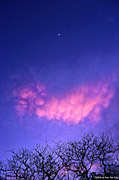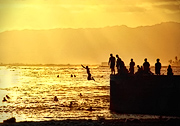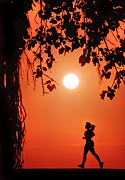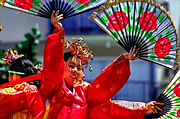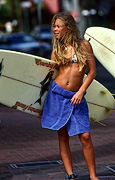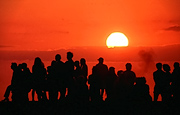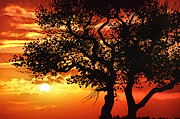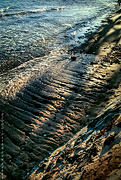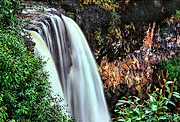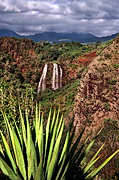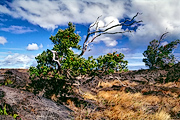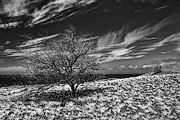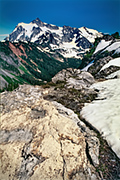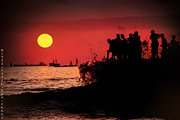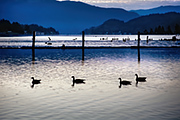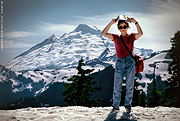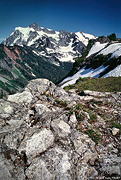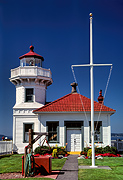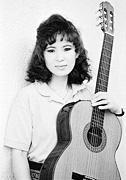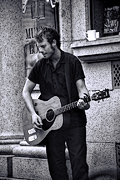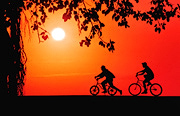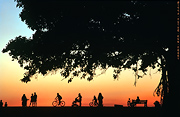.
Canon
EOS 5, A2E & A2
Thoughts from a DSLR Shooter
Peter
Kun Frary
.
.
The EOS 5 is a midrange SLR film camera introduced in 1992. In North American it was called the EOS A2E, or, sans eye controlled focus (ECF), A2, but the rest of the world knew it as the EOS 5.
Woman in Waikiki | EOS A2E, EF28-105 3.5-4.5
USM, Sensia 100
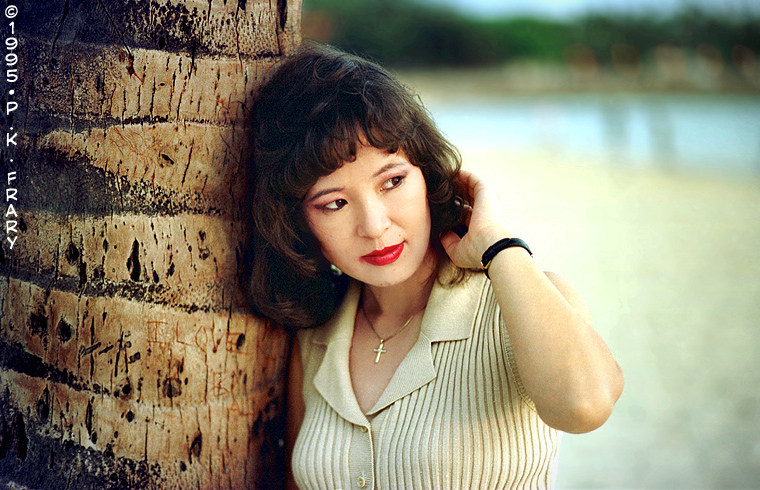
At launch in 1992, the EOS 5 was a cutting edge design with 5-point AF array, 5 FPS silent film advance, 1/8000 to 30 second shutter range, 1/200 flash sync, two control wheels, PC Socket, mirror
lockup (prefire), interchangeable focusing screens and Eye Controlled Focus (ECF). Many of these features and this control interface are still standard on current mid-range EOS DSLRs. A modern day EOS digital shooter will feel right at home with the controls of an EOS 5.
I owned three
of these cameras since 1992—EOS 5, A2E and A2—and their unique fusion
of advanced features, light weight and ease of use made them
my workhorse cameras for well over a decade. With a production span of 10 years, the EOS
5/A2E/A2 was manufactured longer than any
other EOS model. This longevity is a testimony
to its excellent design and performance.
EOS A2 | My A2 used to have a satin finish on the grip but it wore off.
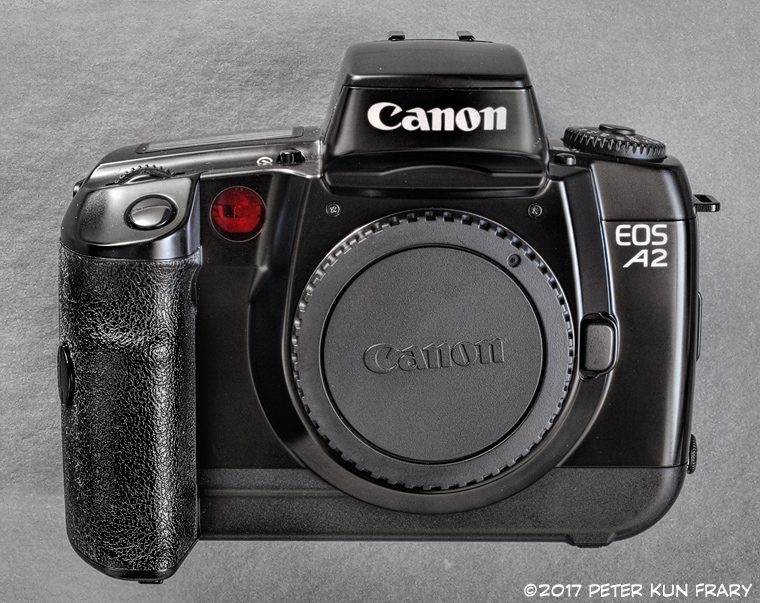
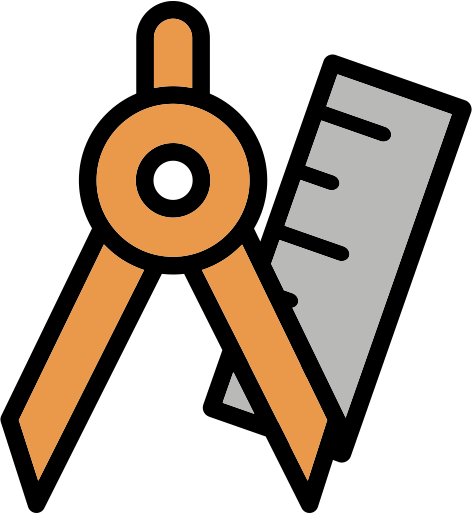 Construction Construction
The EOS 5/A2E has a fiberglass
reinforced polycarbonate shell with metal lens mount and pressure plate. It's larger
and heavier than the Elan 7E. It flexes slightly when you squeeze it due to
predominantly plastic construction. However,
there are advantages to fiberglass reinforced
polycarbonate over metal. I had an accident with
a Manfrotto quick release and my A2E fell four feet
with a Sigma 100-300 APO zoom onto a concrete dock. It
bounced off the tripod leg and hit the concrete
dock lens shade first and, amazingly, only
suffered a ding on the bottom. I removed
the shattered UV filter and finished the roll of
film (the lens shade fell in the ocean). A
similar drop with a metal camera some years
earlier resulted in a big dent, a cracked
pentaprism and jammed mechanism. Polycarbonate
absorbs impact better than
metal.
As proved by
several drops and many bangs, the body is tougher
than it appears (plastic flexes and bounces well!).
Unfortunately, the finish is more delicate and
prone to scratches and finish wear than the EOS 3 or Elan
7E.
The EOS 5/A2E/A2 is a quiet camera
due to its "Whisper" drive. The mirror slap is
slightly louder than the Elan 7E, but much
softer than the EOS 3. Like the original Elan (EOS 100),
the EOS 5/A2E's only noisy component is the auto zoom
pop-up flash. The EOS 5 was so quiet for its day models, expecting to hear the film advance motor, often wondered whether or not I took the picture.
A multitude of exposure modes | PIC modes for non-technical users (sports, macro, portrait, etc.) plus programmed AE, aperture priority, shutter priority, manual, X-sync and depth of field (DEP). P, AV and TV modes have -2 to +2 of exposure compensation and auto bracketing available.
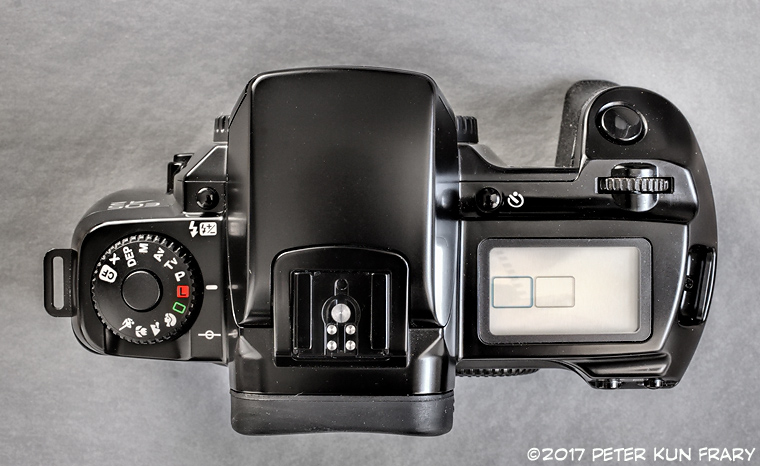
 Auto Focus Auto Focus
Five-point
wide area auto focus with center cross and 4 single axis sensors were cutting edge in 1992. Sadly, Canon didn't improve much on this basic design for their mid-range cameras until the release of the EOS 40D in 2007 (all cross points).
Like current XXD and 5D series DSLRs, the AF rectangles involved flash red when AF is
achieved. All 5
sensors may be active or individual sensors are
user selectable via ECF or buttons and wheels.
In low light
situations the EOS 5/A2E is a little better than the Elan
and Rebel series. First, the viewfinder is
noticeably brighter, more contrasty and bigger.
Second, AF and metering are more sensitive
in low light than the Elan 7E. Canon rates EOS 5/A2E
metering range at EV 0 to 20 and AF range at EV
0 to 18, a full stop more sensitive than the
Elan 7E. Third, the near infrared AF assist
light is more elegant than the blinding white
strobe of the Elan 7E.
All auto focus
SLR cameras share similar limitations when
shooting in low light. EOS A2 owners won't
notice problems if they stay within the AF
assist light range, about 25 to 30 feet.
However, once outside of this range, it is
crucial to use fast lenses and focus on points
of contrast. In other words, you can't merely
point 'n shoot when lighting gets dim. You must
pick your targets carefully.
Water Lily | Canon EOS A2E, EF 200 2.8L USM and Sensia 100
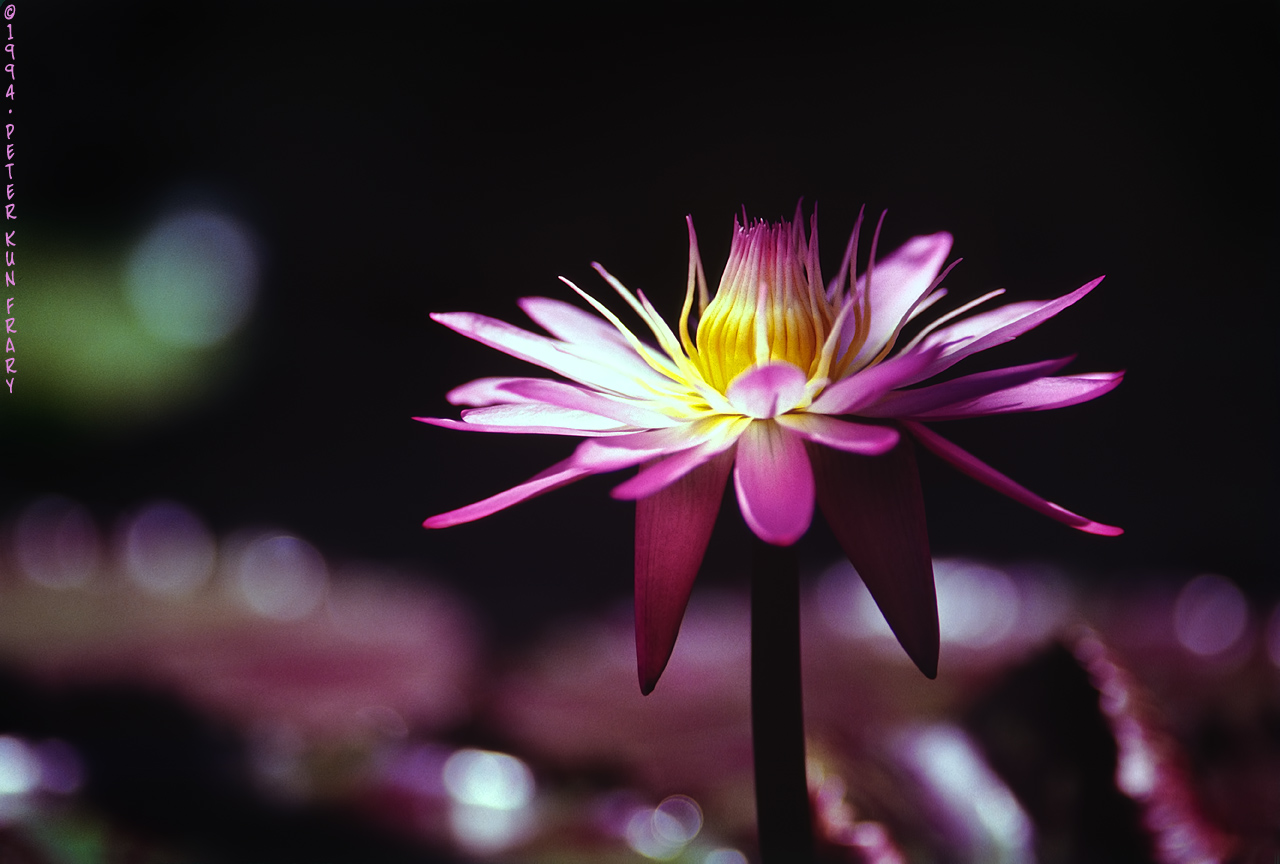
 Eye Controlled Focus Eye Controlled Focus
ECF rocked the photographic world when it appeared in the EOS 5/A2E in 1992. Focus may be achieved by looking at the subject while pressing the shutter button. One of the five AF sensors in the viewfinder confirms focus by flashing red. Foreground? Background? Off-center subject? It's your choice. No more locking focus and recomposing. The gotcha is ECF only works in landscape orientation for this model. For vertical or portrait orientation you'll have to select AF points via wheel and/or buttons. The EOS 3, Elan IIE, Elan 7E and Elan 7NE have newer ECF designs and work in both landscape and portrait orientation.
For ECF to work, it must be calibrated for your eye. Another person's calibration won't work for you. Calibration is simple: twist the knob to CAL and look at flashing rectangles while pressing the shutter. Calibrations are cumulative, i.e., the camera learns to track your eye better with each calibration, especially if you calibrate with different lighting and lenses. It took me about a dozen calibrations to achieve consistent results. However, once calibrated, ECF was fast and reliable in good light.
EOS A2 back | Many of the rear controls such as the QCD, AF point selection and AE-lock are similar in placement and function to modern DSLRs. The EOS 5/A2E/A2 was the second
consumer camera to use a large rear thumb wheel
to adjust exposure compensation, aperture,
etc.
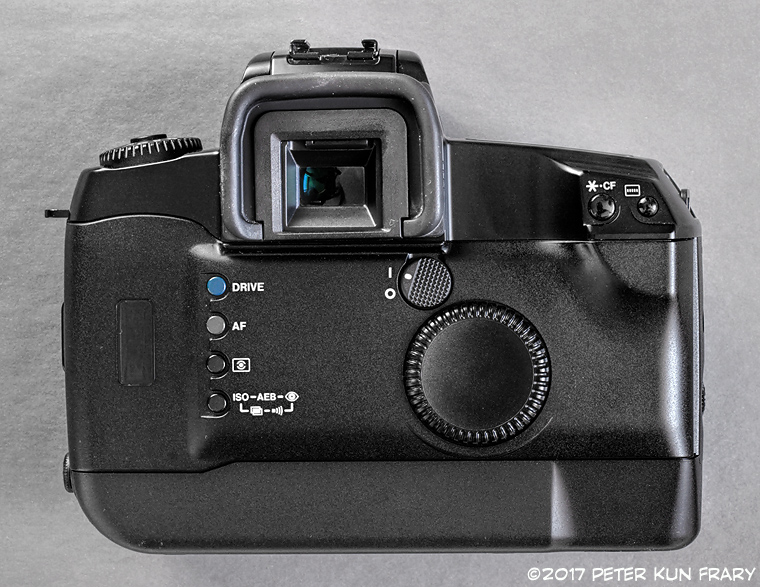
 Exposure
Meter Exposure
Meter
The EOS 5/A2E
offers three meter patterns: 16-zone Evaluative,
center weighted and a 3.5% spot. A partial meter
pattern (large spot) is not available.
The 16-zone
Evaluative metering system is good and
delivers excellent exposures in all but the most
extreme situations. For example, with a
telephoto lens, the Evaluative meter
underexposes blazing Hawaiian sunsets and thus
requires +.5 to +2.0 exposure compensation.
Instead, I spot meter a section of sky I wish to
appear medium toned and let the highlights and
shadows fall into place. Hazy sunsets meter
perfectly. Nevertheless, the situations that
require spot metering or exposure compensation
are far and few between.
Like all
multiple AF sensor EOS cameras, the EOS 5/A2E bias
exposure slightly towards the AF point and tends
to average the overall scene.
Water Lily | Canon EOS A2, EF 200 2.8L USM, and Fujichrome Sensia

 Flash Flash
The EOS 5 and variants sport an auto zoom
pop-up flash, a feature most early 1990s SLRs lacked. The built in flash has a
guide number of 13 meters (43 ft.) at ISO 100,
1/200 flash sync, TTL metering and 28mm to 80mm
auto zoom. Flash AE compensation and second
curtain sync are available.
The performance
of the EOS 5/A2E's A-TTL/TTL flash system is excellent.
With the pop-up flash, 430EX Speedlite and 420EZ
Speedlite I got consistently well exposed
images, even in point 'n shoot modes. The
EOS 5/430EZ combo was especially effective in
bounce mode. Moreover, the EOS 5/A2E handles off-center
subjects surprisingly well, nearly as well as
the Elan 7E or EOS 3.
The pitfalls of the system are
simple and predictable: predominately dark
subjects are overexposed and predominately light
subjects are underexposed. Average distribution of light
and dark areas (18% medium tones) come out
perfect. Fortunately, the EOS 5/A2E provides flash
exposure compensation (-2 to +2 in half stop
increments) to counter exposure problems.
On-camera flash exposure
compensation works with both the pop-up flash and
external Speedlites.
The best
flash for the EOS 5/A2E is the 540EZ, the last full
featured A-TTL Speedlite. If you have an eye for
the future, consider the 550EX
as it has most of the 540EZ's advanced TTL
features plus E-TTL circuits compatible with
newer EOS bodies. Although you can't use most
E-TTL features with the EOS 5/A2E, wireless
operation is available in manual flash mode.
Canon states
that the EOS 5/A2E is fully compatible with older
A-TTL/TTL Speedlites, e.g., 200E, 300TL, 300EZ,
420EZ, 430EZ and 540EZ. It is also compatible
with newer E-TTL Speedlites but in TTL mode only,
e.g., 220EX, 380EX, 420EX and 550EX. I have
personally used the 220EX, 420EZ, 420EX and
430EZ Speedlites on the EOS 5/A2E with good
results.
There is one
flash gotcha: the EOS 5/A2E disables AF assist lights
on Speedlites and defaults to the built-in AF
assist light. Canon did this because in 1992
Speedlite AF assist only covered the center AF
sensor. Unfortunately, large lenses (e.g., EF
300 2.8L USM) partially block the AF assist
light making AF unpredictable in darkness. There
are now several Speedlites capable of covering
all 5 AF sensors. I wish Canon provided a
firmware update to correct this
problem.
Hilo Bay, Hawaii | Canon EOS A2, EF 28-105 3.5-4.5 USM and Elite Chrome

Custom Functions
The EOS 5/A2E has 16 custom functions or special settings that allow you to customize camera operation to your liking. My favorite custom function is no. 12, mirror lockup. In self-timer mode the mirror locks up and a picture is taken two seconds later. Unlike the EOS 3 and Elan 7E, mirror lockup only works in self timer mode, making it unnecessary to cancel the custom function when you resume normal picture taking. This implementation is less hassle and an excellent substitute for a cable release. This is a good thing because I hate the 60T3 cable release, especially trying to attach it in the dark.
Under The Banyan | EOS A2E, EF 28-105 3.5-4.5 USM and Fujichrome 100
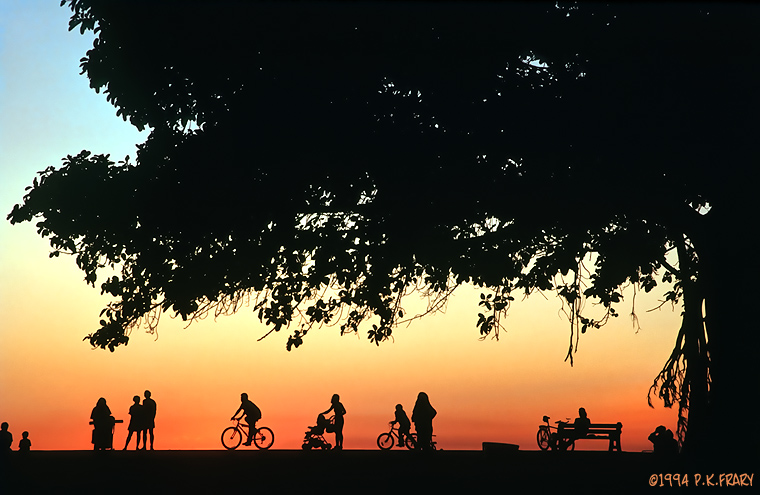
Battery
For an early
nineties design the EOS 5/A2E is extremely power
efficient. I average about thirty-five
36-exposures rolls before the 2CR5 battery dies.
This would be excellent even for a new "power
efficient" design. Plus, I frequently forget to
turn off the EOS 5/A2E for weeks and battery life isn't
impacted much. The EOS 5/A2E was years ahead of its
time and this one of the reasons this camera
remained in production for so long. The ease
of handling puts my EOS 3 to shame and the low
light performance with a slow zoom is better
than the Elan 7E, EOS 1N and EOS 3 (probably the
IV too, but I haven't tried that
model).
Manual Mode
If you decide to
buy an EOS A2 or A2E, consider the non-North
American variant, the EOS 5. It's identical in
all aspects except the EOS 5 sports an analog
display in manual mode rather than a stupid "+"
or "-." The analog display shows how many stops
you're off from the meter with a ruler-like
graphic (-2 -1.5 -1 0 +.5 +1 +1.5 +2). With the
simple "+" and "-" on the A2/A2E you merely know
you are over- or underexposed, but not how
much.
Canon EOS A2 | EF 85 1.8 USM and Kodak
TMY
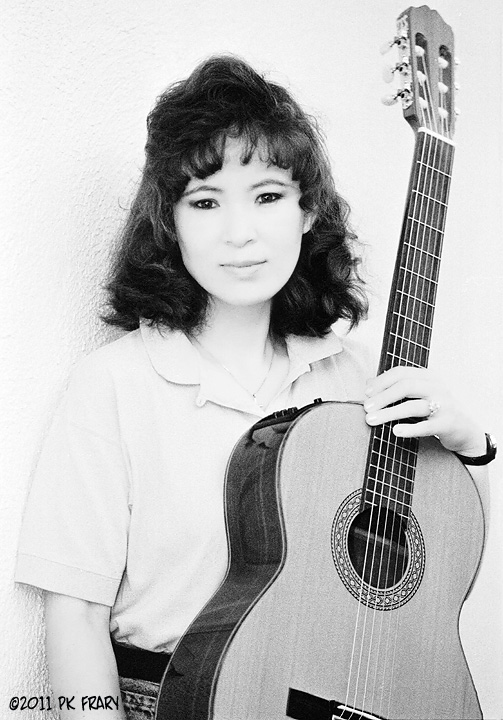
Shiftable
DEP Mode
The EOS 5/A2E, Elan
and IX have a feature that most later EOS SLRs
lack: shiftable DEP mode. DEP mode refers to
depth of field auto exposure. By focusing on the
nearest and farthest points desired in focus,
the camera automatically sets hyperfocal
distance and aperture to render everything
within those two points sharp. The EOS 5/A2E, Elan
and IX allow you to shift the program to
increase or decrease depth of field (I normally
increase depth of field).
Water Lily | EOS A2E, EF 200 2.8L USM and Fujichrome 100
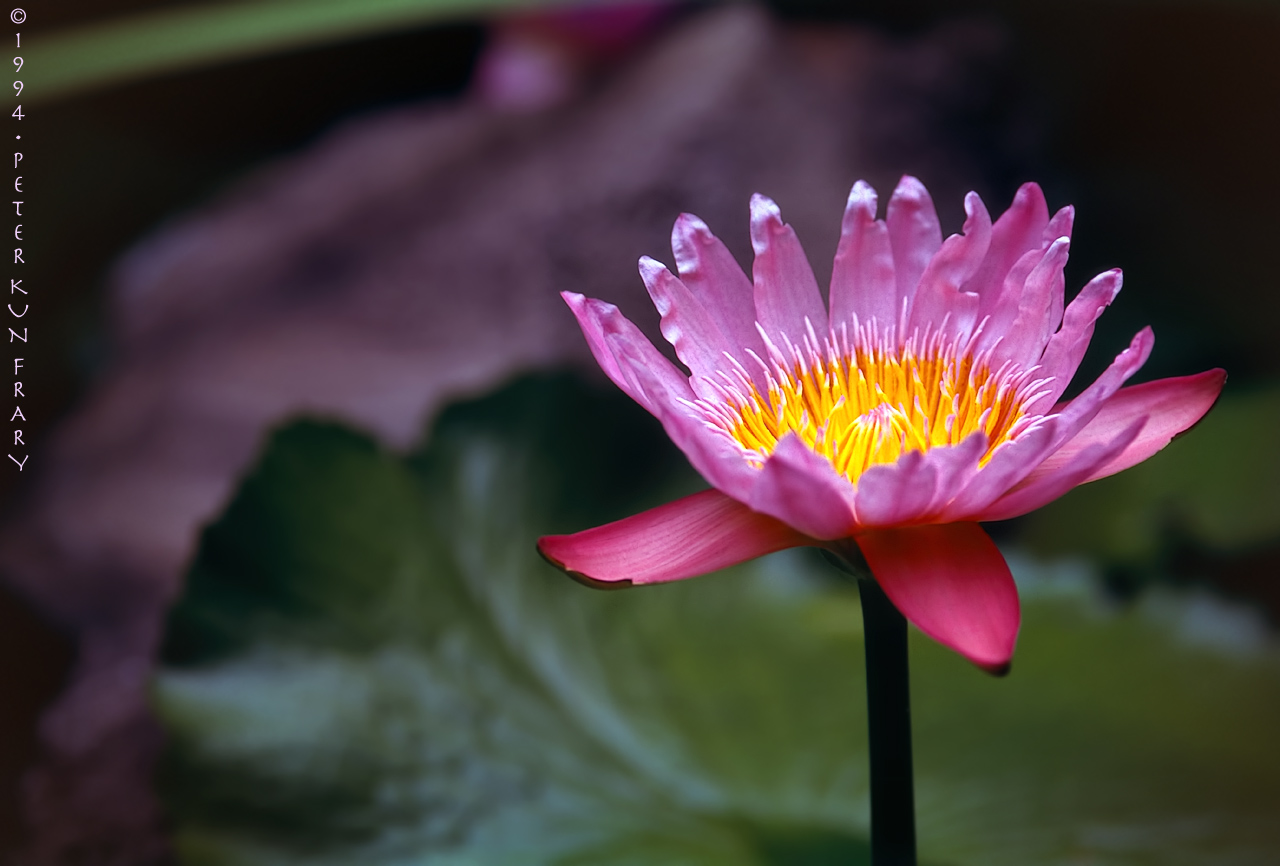
Accessories
The most
universally useful accessory is the VG10,
Vertical Grip. Besides increased grip surface,
it boasts a duplicate set of controls for
vertical shooting: shutter button, AE lock
button, main dial and AF focusing point
selection button. It has a tripod socket and two
sets of strap lugs for a hands trap and
necks trap. My EOS 5/A2E never leaves home without a
VG10 attached.
The EOS 5/A2E has a
3-pin socket for the Remote Switch
60T3 or other T series accessories (now obsolete). The
threaded attachment of the is 60T3 fiddly and
slow, especially in the dark. Too bad the RC-1/RC-6
Wireless Remotes don't work with this
camera.
Dioptric adjustment lenses available
from +3 to -4 are available for the EOS 5/A2E. These are the same lenses used
for the EOS 3 and Elan 7E. However, if you have the EOS A2, the built-in
dioptric adjustment of +.75 to 2.75 should be
sufficient for most folks. The EOS 5 and A2E
lack built-in dioptric adjustment.
Five
user interchangeable focusing screens were available
in North America: Ed-N, Standard Matte
(included); Ed-O, Screen with Focusing Marks
(instead of rectangles); Ed-D, Matte Screen with
Grid (composition aid); Ed-H, Matte Screen with
Scale (for high magnification photography); and All Matte Screen (no frames). A
sixth screen, the Panoramic Matte Screen, was
only available in Japan.
I find the
grid focusing screen (Ed-D) indispensable as a
composition aid. My horizons are consistently
straight now! Plus, cleaning is easier with
a removable screen (you can blow off both sides
of the screen).
Puu Ualakaa State Park and Diamond Head |
EOS A2 and EF 28-105 3.5-4.5 USM | Fujichrome 100

Gotchas
Certain batches
of this camera are prone to command (mode) dial problems (1998-2000
batches are said to have an improved dial). I
always pressed the release button when turning the
command dial on or off and, yet, my 1996 A2 had
two failures within five years (my 1992 A2E had
no dial failures). At $120 a crack, this ain't
funny. My second command dial was installed
during Summer 1999 and was still going strong 6
years later when I sold it. In all
fairness, the dial does not break as easily as
reported by internet cry babies provided
you:
- Press the
locking button when tuning it on/off or
switching from Basic Zone to Creative Zone. It's easy to forget to do this one little thing...
- Don't spin
the dial needlessly like a roulette wheel.
- When
shooting, leave the camera on to
minimize dial wear.
The EOS 5/A2E/A2
disables AF assist lights on Speedlites and
defaults to the built-in AF assist light.
Unfortunately, large lenses (e.g., EF 300 2.8L
USM) may block the AF assist light
making AF unpredictable in low light.
 Final Blurb Final Blurb
After using three EOS 5/A2E/A2 cameras for over ten years, I can say this is
one of Canon's best designs of the 1990s: a near perfect
harmony of advanced features, high performance
and ease of operation. The superior low light
AF due to an assist light, interchangeable focusing
screens, 5 FPS motor drive, PC socket and 1/200
flash sync give it an edge over the Elan 7
for serious shooters. My EOS 5/A2E/A2 cameras cranked out
well exposed and focused chrome after chrome for
hundreds of rolls. They never jammed or locked
up, even with old Sigma lenses!
I find the EOS 5/A2E/A2
implementation of mirror lockup fast and
convenient: enable self timer (with 2 or 10 sec. delay) and press shutter button. Other
cameras—EOS 3, 1V and Elan 7E—require setting
a custom function and then pressing the shutter for
lockup, press it again for exposure
and, finally, back to the LCD to disable the custom
function!
The EOS 5 was my
favorite camera for a decade and earned its
bacon repeatedly. Although an
older design, it still holds its own and in some
ways is better than newer EOS film cameras such as the Elans.
 Source
Materials Source
Materials
Canon EOS A2
Instructions (CT1-1002-004). Canon Inc.,
1992.
More Images
taken with the Canon EOS 5/A2E/A2 (click to
enlarge)
06/22/2017 | Revised 11/24/2023

©Copyright 2017-24 by Peter Kun Frary | All Rights Reserved
|
